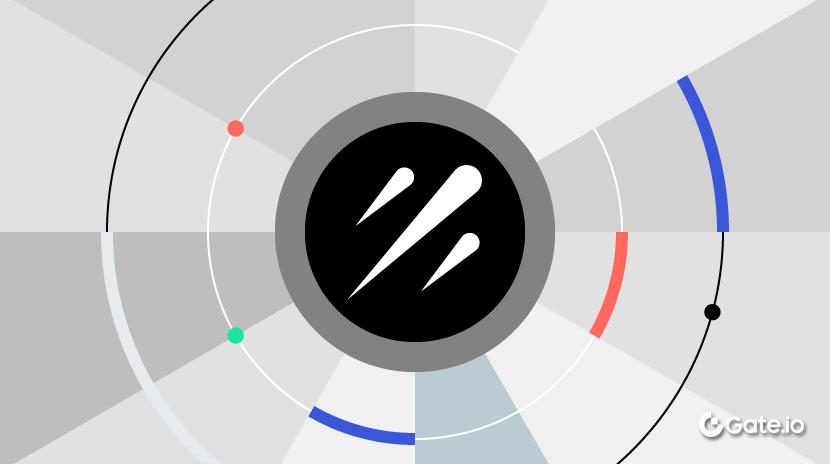Комплексный отчет: Эволюция MEV на Solana и ее плюсы и минусы
Предисловие
Solana существует уже пять лет, а Jito (лидер в инфраструктуре MEV на Solana) развивается менее трех лет. Тем не менее, его рыночная доля быстро выросла с первоначальных 15% до текущих 95%. Можно сказать, что большинство сделок по покупке и продаже Meme на Solana должны проходить через него! Здесь нет рекламы, поэтому просто расслабьтесь, нажмите на кнопку «Избранное» и погрузитесь в основные принципы, постепенно раскрывая...
- Что такое Jito-Solana? Почему он завоевал рынок за два года?
- В чем различие основного механизма Solana от механизма Ethereum?
- Почему вашу транзакцию часто сжимают?
- Как будет развиваться MEV ландшафт на Solana в будущем?
1. Что такое Jito-Solana?
Конечно, Jito-Solana не единственный поставщик инфраструктуры MEV на Solana (с долей рынка 95%). Существуют и другие, такие как Paladin, Deeznode, BlockRazor, BloxRoute, Galaxy, Nozomi и так далее, каждый с различными точками входа. В этой статье будет сосредоточено внимание на процесс разработки и технические принципы основного лидера, а затем будут обсуждены преимущества, недостатки и точки входа этих других компаний.
1.1. График развития Jito
Давайте посмотрим на быстрое развитие доли рынка через временной интервал, сосредотачиваясь на уровне стейкинга и связанных партнерах.
- Основан в конце 2021 года
- Запущен на основной сети Solana в июне 2022 года, с 200 валидаторами к сентябрю, охватывающими 15% объема стейкинга
- 2022-2023: Финансирование, итерация и сотрудничество с Фондом Solana, с включением клиента Jito в официальные рекомендации
- 2023 TGE: Стейкинг Jito для заработка наград MEV, создание модели рестейкинга
- 2024 год: Из-за сильного противодействия сообщества Jito-Solana закрыл канал для отправки транзакций в Jito-Blockengine
- Q2 2024: Более 500 сотрудничеств валидаторов, охватывающих 70% MEV Solana, с обработкой 3 миллиардов транзакций в 2024 году
- 1 кв. 2025 г.: Охват стейкинга достигает 94,71%. Сегодня важность мостов между цепями остается неоспоримой.

[Источник: https://www.jito.network/zh/stats/]
Следовательно, можно сказать, что Jito является ведущим поставщиком инфраструктуры в экосистеме MEV на Solana. За последние три года развития он построил прочное основание поддержки от валидаторов Solana, сделав так, что подавляющее большинство транзакций должны проходить через систему Jito.
Именно благодаря системе Jito время простоя Solana значительно сократилось.
Именно Jito позволил атакующим сторонам в сэндвич-атаках заработать высокие прибыли.
Это также Jito, который постоянно и стабильно предоставляет валидаторам Solana дополнительные 30% вознаграждения MEV.
Более того, Джито превратился из первоначального убийцы драконов в самого дракона, переключаясь между ролью героя и злодея, иногда свирепого, иногда милосердного.
В сегодняшнем основном мемном рассказе Джито стал двуликим оператором, преуспевающим в обоих направлениях.
1.2. Что именно построил Джито?
Фактически он состоит из трех основных служб: блок-двигатель, jito-solana и jito-relayer. Их взаимоотношения показаны на схеме ниже:

[Источник: Создано Шиси-Джун]
Во-первых, это block-engine, который представляет собой аукционную систему. Его типичный сценарий позволяет злоумышленникам-сэндвичам отправить на аукцион пакет из пяти транзакций в фиксированном порядке. Кроме того, они могут отправить валидаторам дополнительную транзакцию, называемую чаевыми, в качестве небольшого стимула для приоритетной упаковки этого пакета. Другие сценарии включают платформы децентрализованных бирж (DEX), такие как OKX, GMGN и BN Wallet. Чтобы избежать сэндвич-атак, они могут добавить подсказку к транзакциям отдельных пользователей, следуя по маршруту аукциона, чтобы ускорить обработку транзакций.
Далее идет jito-solana, клиент, который заменяет валидаторов для проверки транзакций и создания блоков. Его основная функция - позволить валидаторам получать пакеты Bundle, отправленные блок-движком, что позволяет им приоритизировать обработку этих транзакций и завершить последовательность транзакций. В пике система ежедневно обрабатывала до 25 миллионов пакетов (в настоящее время около 10 миллионов), прибыль за каждый пакет обычно составляет. Конечно, чаевые взимаются в единый счет и затем распределяются валидаторам (95-97%) и самому Jito (3-5%).
Самый контроверзиальный компонент - jito-relayer, который можно понять как шлюз для валидаторов для получения транзакций. Изначально, когда этот ретранслятор получал транзакцию, он задерживал ее на 200 мс перед пересылкой на jito-solana, одновременно пересылая ее на block-engine без задержки. Очевидно, это было продажей данных ордеров. Таким образом, взлет Jito в его ранние дни был вызван разрывом прибыли, вызванным убытками пользователей. Важно отметить, что в марте 2024 года официальное заявление гласило, что они больше не передают данные, но на сегодняшний день jito-relayer все еще содержит переключатель и настройку для задержки в 200 мс. Таким образом, остается неясным, продают ли валидаторы данные пользователей сегодня, особенно учитывая, что block-engine остается закрытым.
1.3. Сколько заработала система Jito?
Очевидно, разрыв в прибыли между транзакциями, нацеленными или нет, в сочетании с введением механизма чаевых, в конечном итоге принес пользу валидаторам, способствуя стремительному росту доли рынка Джито. Кто бы отказался от дополнительных 30% дохода?
В течение прошлого года было инициировано всего 4,3 миллиарда пакетов, и общие комиссионные сборы по чаевым составили 5,51 миллиона SOL. По рыночной цене 140 USD за SOL это привело к дополнительным доходам в размере 7,7 миллиарда USD для инфраструктуры Jito.

[Источник: https://explorer.jito.wtf/]
Однако не все эти доходы идут на счет поставщика системы Jito. Как уже упоминалось ранее, Jito делится 3-5% сборов платформы с валидаторами, так что фактический доход Jito за последний год составил около 200 000-270 000 SOL, примерно 35 миллионов долларов США.
Это сравнимо с доходом Короля Славы за два дня, что на первый взгляд может показаться не очень высоким. Однако это прибыльная платформа, особенно учитывая, что большинство отраслей Web3 даже не могут указать на конкретные доходы.
Jito стал монополистом, обладающим эксклюзивом над другими конкурентами (поскольку валидаторы могут запускать только один клиент), и его доходы недавно пострадали от усталости от мемов. Если Solana сможет исследовать больше сценариев транзакций в долгосрочной перспективе,
и если нет конкурентов на рынке, платформа может изменить свою долю в доходе с 3-5% до 30% (что является обычной ставкой комиссии платформы для интернет-приложений, когда они доминируют на рынке).
Это может привести к очень высокой оценке PE. Используя общепринятый коэффициент PE в 30 для лидеров индустрии Web2, оценка может достигнуть 1 миллиарда долларов США. Используя более типичное умножение в 300 раз для монополий индустрии Web3 и потенциального роста, оценка может взлететь до 10 миллиардов долларов США. Подобные методы оценки упоминаются вСупер посредник или бизнес-гений? Повторное рассмотрение года после перехода LayerZero от V1 к V2.“
Однако сегодняшнее внимание не сосредоточено на таких макро-выводах, и не на понимании Jito через спекулятивные виртуальные оценки. Вместо этого мы стремимся к тому, чтобы погрузиться в детали, понять более глубокие принципы, лежащие в его основе, и проанализировать будущее развитие рынка.
1.4. Какие сценарии спроса может поддерживать Джито?
Эта тема в основном касается наиболее распространенных типов атак MEV, самой частой из которых является Фронтраннинг, такие как:
- Арбитраж: Как и в случае с Ethereum, это операция арбитража без риска.
- Атака сэндвичей: типичная атака сэндвичей, прибыль на Solana от сделки сэндвичем составляет около 2 долларов США за транзакцию.
- Ликвидность JIT (Just in Time): Предоставление операций, предлагающих мгновенную ликвидность.
Еще одной крупной категорией является Backrunning: включает в себя вставку арбитражной сделки после целевой транзакции (например, крупной сделки на DEX или события ликвидации) для получения прибыли от рыночной волатильности, вызванной этой целевой транзакцией. Конкретные сценарии включают в себя:
- Арбитраж на DEX: Вы можете рассматривать это как использование разницы в ценах между различными DEX. Сделка будет совершена немедленно для закрытия арбитражного разрыва.
- После ликвидации: после ликвидации залога пользователя последующая сделка покупает актив по сниженной цене и перепродает его.
- Задержка оракула: Выполняет обратные операции на основе устаревших цен, прежде чем оракул обновит свои данные.
Помимо очевидных сценариев атак, существуют и другие сценарии ускорения, которые также выигрывают от Gate. Поэтому можно с уверенностью сказать, что Gate предназначен не только для MEV, но также обслуживает все сценарии с потребностью в ускоренных или пакетных транзакциях.
Например, во время оживленных активностей по запуску токенов на Solana трейдеры часто используют механизмы пакетирования и ускорения для открытия рынков и развертывания токенов.
Также крупные биржи могут использовать пакетирование чаевых для крупных пользовательских транзакций, чтобы избежать атак. Однако важно отметить, что эти меры не могут предотвратить злонамеренные действия валидаторов (и, на самом деле, нельзя быть уверенным, какой валидатор действует злонамеренно).
2. Подробное сравнение различий между системами Solana и ETH
Почему Jito так хорошо подходит для Solana? Почему на этом рынке нет такого же уровня конкуренции, как на рынке ETH, где есть несколько претендентов? Чтобы понять это, нам нужно рассмотреть различия в системе между этими двумя монетами. Вы, возможно, много раз слышали о консенсусе POH, но жизненный цикл транзакций Solana отличается от Ethereum, что создает явный контраст между их экосистемами.
2.1. Ландшафт MEV ETH
Два года назад, в первую годовщину объединения Ethereum, я провел систематический анализ под названием " Ландшафт MEV год спустя после слияния Ethereum.” В этом анализе была явна разница в жизненном цикле системы Ethereum:

[Источник изображения: https://mp.weixin.qq.com/s/IepFvVpIxLpkXV5qgF68Rw]
Это обусловлено двумя важными изменениями после слияния:
Интервал блока Ethereum стал стабильным. Это уже не был предыдущий случайный интервал между 3 и 30 секундами. Эта стабильность оказала как положительное, так и отрицательное влияние на MEV. С одной стороны, искателям не приходилось спешить отправлять слегка прибыльные транзакции, а можно было подождать, чтобы накопить лучшую последовательность транзакций перед ее представлением валидаторам. С другой стороны, это усилило конкуренцию среди искателей.
Соискатели были снижены. Это побудило валидаторов более охотно принимать аукционы транзакций MEV, что привело к тому, что MEV достиг 90% доли рынка всего за 2-3 месяца.
В результате у нас есть роли, такие как Searcher, Builder, Relay, Proposer и Validator в экосистеме MEV Ethereum.
Жизненный цикл каждого блока выглядит следующим образом:
- Строитель создает блок, получая транзакции от пользователей, искателей или других (частных или общедоступных) потоков заказов.
- Строитель отправляет блок на реле (где может быть несколько строителей).
- Реле проверяет действительность блока и вычисляет, сколько оно должно заплатить предложителю блока.
- Реле отправляет последовательность транзакций и цену вознаграждения (ставку на аукционе) текущему предлагателю блока.
- Предложивший оценивает все полученные ставки и выбирает последовательность с наивысшей наградой.
- Предлагающий отправляет подписанный заголовок блока обратно на реле, завершая процесс аукциона.
- После публикации блока вознаграждения распределяются между строителем и предложителем на основе транзакций блока и вознаграждения за блок.
Таким образом, я верю, что ситуация MEV в Ethereum неизбежно ставит искателей и строителей в ожесточенную внутреннюю конкуренцию.
Фактические данные подтверждают эту точку зрения: общая доходность снизилась значительно на 62%.
- Средняя прибыль до слияния (с сентября 2021 года по сентябрь 2022 года) составляла 22MU/M, включая арбитражный и ликвидационный режимы.
- Средняя прибыль после слияния (с декабря 2022 по сентябрь 2023 года) составила 8.3MU/M, включая арбитраж и сэндвич-режимы.
Вы могли бы возразить, что MEV-ускорение на ETH увеличилось быстрее. Действительно, так оно и есть!
Однако более быстрый рост не обязательно означает более высокую прибыль. Как мы уже анализировали, рост Ethereum обусловлен снижением стимулов для майнеров, что побудило валидаторов принимать аукционы транзакций MEV, позволив MEV захватить 90% рыночной доли всего за 2-3 месяца.

[Image source: https://mevboost.pics/]
Основное различие между ETH и Solana заключается в наличии нескольких строителей, у каждого из которых разные конечные доходы, влияющие на решения валидаторов. Это создает конкуренцию среди строителей.
Из-за этого конкуренция прибыли поисковых систем постоянно сжимается. Помимо алгоритмов, единственным отличителем для строителей становится объем данных, к которым они могут получить доступ.
Искатели, которые не могут конкурировать, покинут рынок, в то время как строители с доступом к большим объемам данных часто имеют собственную инфраструктуру и репутацию на рынке, формируя стабильный поток общих заказов, а не полагаясь на передачу Mempool между узлами.
В результате, по сравнению с более централизованной и олигополистической моделью платформы Solana, рынок MEV ETH более рыночно ориентированный, предоставляя пользователям относительно больше свободы действий.
2.2 Механизм блока Solana
После понимания системы ETH, пожалуйста, проясните свои мысли — многие аспекты Solana отличаются от Ethereum, даже на уровне фундаментальной концепции блоков.
Эти механизмы лежат в основе бурной деятельности MEV в системе Solana.
Мы можем использовать таблицу для быстрого сравнения этих четырех основных функций.

Ключевую роль играют две функции: отсутствие пула транзакций и прямые подключения к лидеру. Первое вводит задержку транзакции, в то время как второе открывает дверь к неправильному поведению валидатора.
2.2.1 Фактически у Solana нет Mempool
Ранее мы упоминали о задержке в 200 мс у Jito и его синхронизации с блочным движком. Это в основном монетизированный пул ордеров. Но в принципе, Solana не использует пул ордеров - это часть ее дизайна для повышения скорости и конфиденциальности. Как это влияет на процесс формирования блоков?
Если вы обычный пользователь, отправляющий транзакцию узлу, это фактически широковещание. По умолчанию узел немедленно определит текущего и следующего лидера (всего два валидатора) и перенаправит вашу транзакцию. Но где определяется порядок транзакций? Всё зависит от того, используете ли вы нативный Solana или Jito-Solana:
- Native Solana: Как только лидер получает транзакцию, теоретически она следует модели FIFO (первым поступил — первым обслужен). Та транзакция, которая первой достигает лидера, включается в последовательность. В сочетании с механизмом POH это делит блок на множество маленьких тиков для синхронной обработки.
- Jito-Solana: Транзакции попадают в очередь, которая вычисляет текущий лимит газа (называемый CU, или Compute Units, в системе SVM). Эта очередь имеет более низкий приоритет, чем Пакетные транзакции. Таким образом, обычные транзакции оказываются после Пакетов. Если кто-то нападает на вас одной и той же транзакцией, Jito-Solana будет отдавать приоритет упаковке атакующих транзакций. Здесь 80% блокового пространства зарезервировано для Пакетов, и только 20% выделяется на обычные транзакции.
Таким образом, Solana не устраняет распространение транзакций — она просто сокращает публичное распространение. Это делает ландшафт MEV Solana более эксклюзивным, благоприятствуя игрокам высшего уровня.
2.2.2 Будущие лидеры предсказуемы
Валидаторы выбираются за каждую эпоху (примерно каждые 2-3 дня) из пула из 1,300 валидаторов с использованием механизма случайной выборки на основе VDF, взвешенного по стейку.
Например, если общая сумма стейкинга составляет 2 миллиона SOL, а вы стейкнули 200 000 SOL, у вас есть 10% шанс быть выбранным. Если вы выбраны, вы будете производить блоки для следующих 4 слотов (эквивалент блоков Solana), что длится примерно 1,6 секунды.
Поскольку этот процесс предсказуем и быстр, любой активный узел может рассчитать, кто будут следующие валидаторы и попытаться заранее связаться с ними, чтобы отправить транзакции пользователей. Из-за сетевой задержки часто бывает, что транзакции пропускают текущего лидера и поступают к следующему.
2.2.3 Стратегия подключения лидера также зависит от ставки
Это осуществляется через механизм SWQoS (Стейк-взвешенное качество обслуживания). Лидер имеет общую пропускную способность подключения P2P в 2 500 пиров. Из них:
80% (2,000 соединений) зарезервировано для узлов, которые заморозили SOL (участники SWQoS).
20% (500 соединений) доступны для не стейкнутых общедоступных узлов.
Это может показаться сложным, но по сути это механизм против спама и сопротивления Сибиле, разработанный для приоритизации сообщений о транзакциях, направляемых через заложенные прокси-валидаторы.
2.3 Почему так легко подвергнуться атаке на Solana?
Многие постоянные пользователи задаются вопросом: можно ли избежать атаки-сэндвича, предлагая высокую Приоритетную Комиссию, чтобы моя транзакция была упакована первой валидаторами? Правда в том, что это помогает немного, но не на много. В крайних случаях это даже может привести к обратному эффекту.

[Источник изображения:https://explorer.jito.wtf/feestats]
Как показывает график, приоритетные комиссии предлагают вероятностное преимущество, в то время как чаевые более волатильны и конкурентоспособны. Кроме того, чаевые представляют собой отдельные транзакции — внешне неясно, какие из них находятся в пакете.
Итак, даже с высокой комиссией приоритета ваша транзакция перемещается только в оставшуюся очередь валидатора на 20% для этого слота. Но если Поиск найдет ваш ордер раньше и запустит атаку сэндвича, используя Пакет (который включает вашу транзакцию), ваша высокая комиссия приоритета просто делает этот Пакет более ценным (более высокая средняя стоимость CU), увеличивая его шансы на быструю обработку внутри очереди Пакетов валидатора и быструю трансляцию.
Точно так же, другие механизмы Solana могут показаться удобными для пользователя на первый взгляд, но у Solana по-прежнему одно из самых агрессивных окружений MEV. Вот почему:
- Лидеры могут вести себя плохо без ответственности
Лидерские слоты идут подряд, что означает, что лидеры A и B могут получить доступ ко всем транзакциям пользователей. Это снижает стоимость и неоднозначность неправильного поведения для лидера B.
Представьте, что вы - лидер B, и заметили прибыльную пользовательскую транзакцию. Вы можете быстро сконструировать атаку сэндвича, отправить ее на аукцион блоков движка и, согласно правилу приоритета 80% пакета, ваша атака скорее всего будет обработана первой, хотя и подготовлена лидером A.
Как кто-то может доказать, что лидер B - это атакующая сторона?
Вы можете утверждать, что лидером А следует винить за включение атаки, но на практике 95% валидаторов будут вести себя так же, поэтому мало стимулов или механизмов для наказания.
- Повторные транзакции и длительные задержки
Каждый слот длится всего 400 мс, но многие пользователи сообщают, что транзакции застревают более 23 секунд. Почему?
Это не плохая производительность узла — это SWQoS. Если у вас есть подключение к обычному (не стейкнутому) узлу, он может найти правильного лидера, но не сможет подключиться во время перегрузки. Поскольку всего 500 слотов подключения зарезервированы для таких узлов, ваша транзакция может завершиться неудачей и попасть в цикл повторной попытки каждые 2 секунды.
Это значения по умолчанию (некоторые узлы настраивают интервал повтора), но на март 2025 года количество валидаторов составляет около 1 300, а RPC-узлов - 4 000. Во время перегрузки 2 700 узлов могут конкурировать за всего 500 соединений по 4 слотам (1,6 с). Если ваша транзакция не умещается, она застревает.
Теперь представьте, что он застрял на узле - что произойдет? Если цена вашего CU слишком низкая, а следующий лидер полон, но все равно видит транзакцию, что, по вашему мнению, произойдет дальше?
Точно — данные продаются. Узлы с высоким объемом торговли могут продавать поток заказов искателям за сумму до $10K в месяц.
- Meme Narrative and Staking-Driven Volume
В настоящее время доминирующим повествованием о Solana являются мем-койны. Эти пулы неглубокие, поэтому пользователям часто приходится терпеть более высокий проскальзывание, чтобы получить заполнение. Это значительно увеличивает прибыль Searcher.
Выборочные данные показывают, что некоторые атаки приносят прибыль в размере $2 за сделку на Solana, по сравнению с ~$0.10 на Ethereum. Это огромная разница.

[Image source: https://www.jito.network/zh/stats/]
Во-вторых, валидаторы Solana зарабатывают около 8% годовых от стейкинга, относительно стабильная цифра на протяжении многих лет.
После внедрения стратегий MEV дополнительный APY от MEV может достигать примерно 1,5%.
Совместно это означает, что валидаторы, работающие с клиентом Jito-Solana, могут увеличить свои доходы от стейкинга на 15–30%.
В некоторых случаях во время всплесков на рынке прибыль MEV даже может превышать базовый доход от стейкинга.
2.4 Почему валидаторы Solana склонны к дефектации?
Прибыль просто слишком привлекательна, в то время как операционные расходы также высоки, заставляя валидаторов постоянно расширять источники доходов.
Валидатор платит примерно 300–350 SOL в год в качестве платы за голосование (при рыночной цене $140, это около $42,000), плюс $4,200 на оборудование, не включая динамические затраты на поддержание сетевой пропускной способности.
Требования к тяжелым узлам Solana требуют как минимум 24 ядра процессора, 256 ГБ ОЗУ и 2×1,9 ТБ NVMe SSD.
Пользовательские машины Latitude, часто используемые в экосистеме (14% валидаторов используют их), стоят около $350 в месяц.
В результате только 458 из 1 323 валидаторов Solana в настоящее время прибыльны. Это одна из основных причин, по которой предложение SIMD-0228 было отклонено. Предложение направлено на дальнейшее снижение вознаграждения за блок, что неизбежно вынудит меньших валидаторов выйти, ускоряя необратимую централизацию.
Теперь подумайте: по мере увеличения дохода MEV и уменьшения вознаграждений основного протокола, что, скорее всего, произойдет? Давайте исследуем, как реагируют конкуренты вне Jito на этот сдвиг.
3. Конкуренты MEV на Solana
3.1 Паладин: VIP фронтраннинг и защита сделок
Текущая доля рынка: ~5%
Запущенный в конце 2023 года, на март 2025 года Paladin утверждает, что 205 валидаторов развернули его клиент, с 53M SOL заложены. Валидаторы, использующие Paladin, сообщают около 12,5% увеличение возврата.
По сути, Паладин является форком и модифицированной версией клиента Jito-Solana.
Его ключевые особенности включают:
- Порт с приоритетом P3: позволяет лидеру, производящему блоки, открывать быстрый VIP-путь, восстанавливая исходный порядок обработки FIFO.
- Обнаружение и фильтрация атак типа 'бутерброд': Хотя на первый взгляд кажется, что это снижает вознаграждение валидаторов, валидаторы Paladin компенсируются с помощью механизма на основе доверия. Избегая атак типа 'бутерброд', они привлекают прямые пользовательские транзакции, создавая доверие в экосистеме и улучшая долгосрочные доходы.
- Бот Паладин: открытый высокочастотный арбитражный бот с открытым исходным кодом, который запускается локально на узлах валидаторов, активируется только когда узел становится лидером. Он выполняет простые, безрисковые стратегии MEV, такие как арбитраж DEX или разрывы цен CEX/on-chain, и направляет прибыль непосредственно в сторону валидатора.
На 3 декабря 2024 года Paladin официально устарел бот.

3.2 bloXroute: Оптимизация сетевого уровня + защита приватных каналов
Компания инфраструктуры bloXroute Labs предоставляет услуги Блокчейн-сети данных (BDN), ускоряя трансляцию транзакций и снижая задержку на цепочках, таких как Ethereum. bloXroute не занимается непосредственным распределением MEV, но помогает операциям фронтраннинга достичь Лидера быстрее, предоставляя более быстрые каналы. В отличие от Jito/Paladin, bloXroute не модифицирует клиент Solana валидатора или не вводит механизмы аукциона для транзакций, а вместо этого предлагает более быстрые каналы сообщений на сетевом уровне для всех узлов. Его основной подход:
- Ускорение Solana BDN: Согласно официальной документации, Solana BDN от bloXroute сокращает задержку распространения блока на 30–50 миллисекунд.
- Служба RPC MEV-Protect: По аналогии с закрытыми портами транзакций Ethereum, bloXroute планирует разрешить пользователям отправлять частные транзакции Лидеру через его RPC, предотвращая просмотр со стороны третьих лиц и обеспечивая защиту от фронтраннинга или атак-бутербродов.
3.3 BlockRazor: Оптимизация сетевого уровня + Защита частных каналов
BlockRazor, недавно созданный проект инфраструктуры MEV в 2024 году, в основном возглавляется отдельными лицами из Азии. Он позиционирует себя как "поставщик сетевых услуг на основе намерений", планируя предлагать MEV Protect RPC, ускорение сети высокой производительности и услуги MEV Builder на основных блокчейнах.
Scutum MEV Protect RPC: Это частная служба шлюза транзакций BlockRazor, аналогичная Flashbots Protect. Пользователи могут отправлять пакеты транзакций через Scutum RPC, и BlockRazor гарантирует, что эти транзакции не будут отправлены через общедоступный пул транзакций, а будут отправлены непосредственно производителям блоков, чтобы избежать фронтраннинга или атак методом "сэндвич".
4. Summary
4.1 Как просматривать конкурентное поле MEV на Solana?
Всего лишь позавчера на сцену вышел новый конкурент: Warlock Labs, собравший $8 миллионов 27 марта 2025 года с целью переформатировать потоки ордеров on-chain. Тем не менее, их основное внимание сосредоточено на Ethereum. Их план заключается в том, чтобы дополнительно предоставить некоторое доказательство и зарегистрировать данные потока ордеров on-chain, чтобы обеспечить точность и ответственность при обработке транзакций пользователей. Это соответствует моему мнению: действительно хороший рынок будет постоянно видеть появление новых конкурентов, в то время как рынок, контролируемый несколькими игроками, ограничит возможности вызова и создаст барьеры. Каким рынком стремятся стать платформенные слои?
Давайте подумаем глубже: что действительно важно в этой инфраструктуре MEV? Paladin построен на jito-solana, что означает, что jito может обновиться до версии, которая больше не поддерживает так называемый канал P3. Это похоже на «битву 3-го квартала» в прошлом, когда победителем становился тот, кто был больше всего нужен (очевидно, социальные сети), и та же логика применялась, когда WeChat запретил делиться музыкой NetEase Cloud в WeChat Moments. Если бы не существовало более крупных регулирующих механизмов, эта исключающая конкурентная стратегия могла бы использоваться бесконечно в любом направлении. Сегодня доля рынка Paladin'а в 5% обусловлена ранним использованием встроенных ботов для увеличения прибыли валидаторов. Несмотря на то, что его боты с открытым исходным кодом предназначены для того, чтобы избежать агрессивной тактики (например, опережения и сэндвичинга, которые наносят вред пользователям), на них все равно оказывалось давление из-за мнения рынка. Другие конкуренты, такие как bloXroute и BlockRazor, идут по пути ускорения и каналов конфиденциальности, где конфиденциальность в конечном итоге ограничивает лидера всего одним пунктом, чтобы избежать должностных преступлений и обеспечить взаимное возмездие в случае неправомерных действий.
Способность к ускорению - это прочная техническая сила сегодня и следующая фокусная точка на рынке кошельков/бирж. Объективно говоря, у оригинального клиентского кода Solana все еще есть определенные исторические долги, поэтому кто-то должен был вмешаться и модифицировать клиент, сделав его более эффективным с более быстрой синхронизацией. В сочетании с механизмом Swqos валидаторы могут улучшить стабильность связи и коэффициент успешности. Кроме того, система блочного движка jito - это многоцентровая система, но даже с несколькими центрами (не полностью децентрализованная), все еще могут возникать единичные точки отказа. Поскольку это является основным компонентом вверх по потоку, любая ошибка здесь фактически равнозначна времени простоя Solana. Поэтому для достижения многократного устранения последствий отказа узлов и ускорения все еще нужно пройти системные испытания, подобные тем, которые ранее проводились. Это объясняет, почему ошибки в кошельке Binance появляются более часто - многие из исторических технических долгов остаются нерешенными.
Однако эта проблема технической мощности в конечном итоге будет решена. Любой может оптимизировать глобальные многонодовые системы, и лидер разместит свою инфраструктуру наиболее эффективным образом, чтобы гарантировать, что его транзакции достигают лидера быстрее. Они даже могут реализовать мультисетевые стратегии для перенаправления различных потребностей пользователей. В будущем конкурентный исход, вероятно, будет зависеть от более утонченных операций. Однако остаётся неразрешимая проблема: сжатие рыночной конкуренции. Если jito-solana использует своё олигопольное преимущество для изменения стратегии приоритета Bundle с 80% до 90% или даже 95%, обычным пользователям придётся бесконечно повышать свои приоритетные комиссии, чтобы конкурировать за оставшееся 5% пространства CU. Но когда общее использование CU недостаточно, это в конечном итоге повлияет на общие награды валидаторов. Со множеством транзакций, накапливающихся в очереди на обработку, стимул к злоупотреблению со стороны валидаторов становится сильнее. Поэтому, если это не абсолютно необходимо, Jito избежал бы запуска такого конкурентного режима.
Итак, почему конкуренция на рынке ETH более открыта, в то время как на Solana она более исключительная? По моему мнению, корневая причина заключается в отсутствии роли торгового строителя. ETH позволяет нескольким строителям создавать несколько окончательных последовательностей блоков, и валидаторы только проверяют и выбирают, какую из них выбрать. С другой стороны, у Solana есть только несколько блочных движков (все от одной и той же компании), и очередь транзакций, предоставляемая валидаторам, представляет собой один пакет (5 транзакций). Это упускает конкурентный аспект наличия нескольких строителей. Объективно говоря, исходя из истории развития ETH, ясно, что эта конкуренция значительно повышает вознаграждение валидаторов, снижая прибыль поисковика. Когда прибыль поисковика уменьшается, атаки становятся менее частыми, что приводит к балансу.
В будущем, когда технологии и рынок выйдут на равновесие, в чем будет истинное конкурентное преимущество? Я верю, что после того, как технологический разрыв будет устранен, сопровождаемый борьбой за таланты и инвестиции, и после того, как будут решены вопросы централизации и децентрализации влияния на общую экосистему Solana, проблема будет решена. Solana уже начала обсуждать несколько строителей и даже далее, начала обсуждения нескольких лидеров и случайного производства блоков. Хотя несколько лидеров означают, что больше людей получат доступ к вашим заказам, поскольку фактический производитель блока выбирается случайным образом из множества одновременных очередей, это косвенно достигает конкуренции среди нескольких строителей. Рыночное воздействие будет следовать аналогичному пути, как и раньше.
Таким образом, истинное конкурентное преимущество сместится к острову данных потока заказов. Например, у Jupiter, который контролирует более 80% рынка DEX, самый большой поток заказов, и теперь ему нужно будет балансировать, предлагать ли лучшие цены или случайным образом выбирать «счастливого гуся», чтобы получить дополнительную прибыль, даже ценой репутации какого-то бренда. Причина, по которой они сами не погружаются в инфраструктуру MEV, может быть связана с этапом развития рынка — никто не может претендовать на такую же неуязвимость, как традиционные гиганты, поэтому сосредоточение на прибыли даст конкурентам возможность обогнать. MEV — это всегда задача теории игр. Как только он достигнет монопольного положения, поддержка валидатора монополиста подтолкнет инфраструктуру к предложению прибыли. Кажется, что любой герой, убивающий драконов, неизбежно становится самим драконом, комбинацией героя и дракона. Конечно, вы можете возразить, что инфраструктура Дзито была создана специально для MEV, так как же он может быть героем, убивающим драконов?
4.2. Вклад и недостатки Jito в Solana
Большая часть предыдущего обсуждения сосредоточена на недостатках Jito, но у Jito есть ли какой-то вклад? Объективно говоря, у Jito есть вклад. Когда я начал изучать Solana три года назад, я отмахнулся от нее (хорошо, я признаю, что тогда был слишком громким), но причиной такого анализа была высокая частота отказов.
Почему был такой высокий процент простоев? С одной стороны, в раннем коде было слишком много проблем, а позже выяснилось, что большинство проблем можно решить за деньги (конфигурации машин постоянно обновлялись). С другой стороны, свою роль сыграла стратегия FIFO: когда в блокчейне появлялась высокоприбыльная сделка, даже если это была просто атака backrun, чем ближе к сделке, тем выше прибыль. Очевидно, что каждый Searcher создавал свою собственную инфраструктуру, чтобы отправлять транзакции лидеру как можно быстрее, поэтому ранние лидеры часто подвергались атакам. Появление blockengine создало процесс торгов. Как только вы видите прибыль, вы сразу же делаете ставку на нее, и трафик перенаправляется. На этом аукционе также была функция перехвата неудачных сделок. Если ваша транзакция конфликтует с чьей-то транзакцией, а цена другого пользователя была выше, то, поскольку оба пользователя искали одну и ту же транзакцию, возникнет конфликт хранилища. Если вы не можете выиграть торги, blockengine напрямую отклоняет вашу транзакцию, заставляя вас повысить ставку и продолжить аукцион (в этом отказе также есть некоторая случайность, которая может заставить вас думать, что вы должны делать дальнейшие ставки, как в сценарии «большие данные, убивающие знакомство»). Конечно, вы можете спросить, почему мы до сих пор видим много неудачных транзакций на Solana? Это связано с тем, что blockengine является многоцентровым. Из-за скорости блока 400 мс он изо всех сил пытается быстро синхронизировать данные, что приводит к ошибкам аукциона между различными блок-движками. Поэтому я считаю, что Jito внес свой вклад, поскольку значительно сократил время простоя Solana.
Помимо времени простоя, связывание транзакций привнесло на рынок несколько сценариев использования. Для процветания рынка необходимо хорошо обслуживать рыночных криейторов. Самым взрывным сектором для Solana стал Мем-рынок, который сильно зависит от группы запуска, которая должна 'скрытно' начинать собирать низкореальные токены сразу же после их запуска. Это очень целевая ситуация - если оператор рынка не сможет собрать достаточное количество прибыльных низкореальных токенов, они могут оставить ралли и перезапустить запуск. Это ситуация 'проигрыш-проигрыш', потому что оператор потратит целый запуск. Кроме того, в других сценариях использования, таких как децентрализованные биржи (DEX), теперь доверяют Jito-Solana не продаавать данные открыто, как раньше. Так что для высокоценных транзакций пользователей поощряют дать чаевые, чтобы использовать быстрый маршрут через blockengine, который занимает 80% очереди обработки CU, ускоряя транзакцию и избегая фронтрана.
Джито также увеличил награды за стейкинг для валидаторов Solana, улучшив общий уровень децентрализации. Как было ранее проанализировано, награды за стейкинг Solana составляют примерно 8% годовых, а с MEV-наградами Джито это может достигать примерно 10%, что является хорошим показателем. Среди 1 323 валидаторов Solana лишь 458 прибыльны. Остальные не совсем убыточны (иначе кто бы продолжал это делать?). Некоторые либо действуют злонамеренно, либо имеют косвенные мотивы, такие как ускорение Swqos. Представленная статистика основана на наградах за стейкинг, не включая награды MEV. Именно благодаря существованию Джито оставшиеся 800 валидаторов стали прибыльными, предотвращая излишнюю централизацию Solana. Поэтому с общей точки зрения Джито-Solana заслуживает признания. По крайней мере на данный момент, она еще не полностью приняла стратегию исключительной конкуренции, что все еще оставляет место для участия сторонних участников.
4.3. Как будет развиваться ландшафт MEV в будущем?
Как уже упоминалось, есть несколько ключевых моментов. Я считаю, что в настоящее время рынок кажется доминирующим одним крупным игроком с несколькими сильными конкурентами, но на самом деле здесь есть возможность, которая таится в тени.
Во-первых, прибыль MEV на Solana обычно выше (около $2 по сравнению с $0,1 в Ethereum), что будет продолжать поддерживать тренд мемов и создавать вечные торговые возможности в различных сценариях. Это означает, что на рынок войдут новые участники. Хотя более высокая стоимость получения потока ордеров на Solana отпугнула меньших игроков, конкуренция среди крупных игроков будет усиливаться по мере увеличения прибыли, что приведет к большим инвестициям.
Во-вторых, на Solana существует значительное противодействие инфраструктуре MEV, что заставило Jito закрыть свои каналы продажи данных и Paladin удалить встроенную функциональность бота. В предложениях, таких как SIMD-228 и уже утвержденном SIMD-96, часть вознаграждений, которые ранее получали валидаторы (изначально сумма базовых сборов и приоритетных сборов), теперь сжигается. Только половина базового сбора будет сожжена, что косвенно увеличит вознаграждения для валидаторов, обрабатывающих обычные пользовательские транзакции, тем самым повышая их мотивацию противостоять снижению веса обычных транзакций Jito. Новые предложения продолжают участвовать в макро процессе принятия решений для Solana.
Третий, общий потенциал прибыли от MEV значителен. Например, в октябре прошлого года доход от комиссий Jito Labs составил 78,92 миллиона долларов, вдвое превысив рекорд в 39,45 миллиона, установленный в мае. Это было больше, чем у традиционных протоколов DeFi, таких как Lido и Uniswap. Даже если Jito должен делить прибыль с валидаторами, общая прибыльная маржа, представляющая минимальные потери для пользователей, остается большой. Чем больше потери, тем сильнее мотивация, и ожидания пользователей относительно надежных услуг можно количественно оценить. Здесь появляются возможности для BlockRazor и bloXroute.
Кроме того, меня вдохновляют еще более передовые исследования:
- Транзакции, основанные на конфиденциальности: Пороговое шифрование, Задержанное шифрование и Шифрование SGX направлены на шифрование информации о транзакциях и применение условий дешифровки, которые могут включать временные блокировки, мультиподписи или модели доверенного оборудования.
Честная торговля: такие концепции, как Fair Sequencing Service (FSS), MEV Auctions, MEV-Share и MEV-Blocker, предназначены для поиска компромисса между отсутствием прибыли и разделением прибыли, позволяя пользователям самим решать, какую цену они готовы заплатить для достижения относительной справедливости в транзакциях. - Уровень протокола: PBS (Proposer-Builder Separation) в настоящее время является предложением от Фонда Ethereum, но его реализация через MEV-boost создала разделение. В будущем такие основные механизмы, вероятно, станут частью собственного протокола Ethereum.
Многие из этих идей уже были предложены в рамках Ethereum, но из-за различий в совместимости они еще не появились в поле зрения пользователя. Тем не менее, это области, из которых Solana также может поучиться и принять.
5. Заключительные мысли
Окончательная цель конкуренции часто не превосходится усилиями в рамках того же трека. Это не будет следующий Jito, который снесет Jito (так как у него тоже есть свои достоинства и недостатки), а совершенно новая форма приложения. В моем раннем исследовании, " Анализ протокола UniswapXЯ подвел итоги операционного потока и источников прибыли UniswapX, с целью полностью описать конкретные доходы от MEV. В конце концов, это источник, с которым он борется и распределяет вознаграждения пользователям (в сущности, жертвуя реальным временем транзакций в обмен на более выгодные цены обмена). Точно так же, основанные на ордер-буке биржи (даже децентрализованные биржи) также являются мощными инструментами против MEV. Поскольку вычислительная мощность продолжает улучшаться и ежедневные транзакции увеличиваются, механизм AMM и соответствующие сценарии атак MEV будут постепенно рассеиваться. Однако, вызовы, с которыми сталкиваются ордер-буки, не меньше, чем у MEV.
Из недавних потрясений Hyperliquid очевидно, что помимо забот о централизации, поскольку экосистема web3 движется к соблюдению регулирования, игроки за столом уже надели свои костюмы и вошли в международные залы. На данный момент соблюдение является всеобъемлющим мечом, поскольку в конечном итоге стоит на стороне пользователей.
Этот статья, охватывающая тысячи слов, логически обоснована и основана на данных, с выводами, сделанными на основе различных статей. Благодаря исследованиям, которые способствовали развитию отрасли!
Оговорка:
Эта статья взята из [ Четырнадцатый июн], и авторские права принадлежат оригинальному автору [Четырнадцатое июня]. Если у вас есть возражения против перепечатки, пожалуйста, свяжитесь с Gate Learnкоманда, которая обработает это как можно скорее в соответствии с соответствующими процедурами.
Отказ от ответственности: Взгляды и мнения, выраженные в этой статье, представляют только личные взгляды автора и не являются инвестиционным советом.
Другие языковые версии статьи переведены командой Gate Learn. Переведенную статью нельзя копировать, распространять или плагиатировать без упоминания Gate.Gate.com.
Похожие статьи

Что такое Tronscan и как вы можете использовать его в 2025 году?

Что такое индикатор кумулятивного объема дельты (CVD)? (2025)

Что такое Нейро? Все, что вам нужно знать о NEIROETH в 2025 году

Что такое Solscan и как его использовать? (Обновление 2025 года)

15 криптовалютных проектов уровня 1 (L1), на которые стоит обратить внимание в 2024 году


